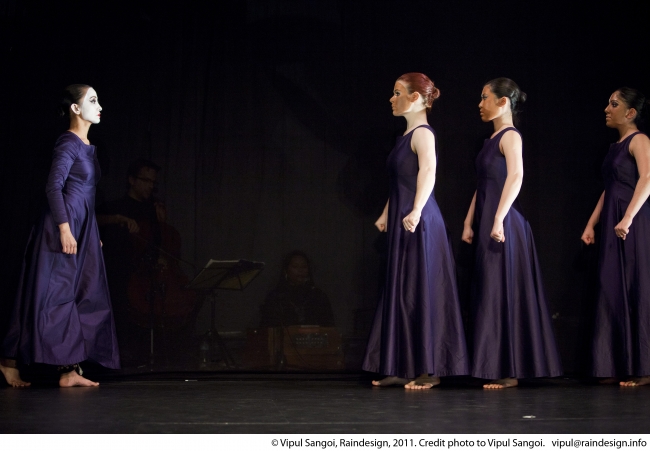Three women sitting on a dimly-lit stage, each in her own space, hands busy folding and arranging. The music intensifies, and they rise, and dance. One is presented with a garland, and she twirls ecstatically, the picture of happiness on her wedding day, the two others reflecting her joy and supporting her. The pattern is established: heroine and chorus. Renowned Kathak dancer and choreographer Amina Khayyam plays Federico Garcia Lorca’s angst-ridden and desperate Yerma, whose barrenness becomes an obsession. Dancers Lucy Teed and Jane Chan (former students of Amina Khayyan and of her mentor Alpana Segouta) play everyone else: her husband, friends, sisters, village gossips.
Because the low lighting is mostly focused on Yerma in the first scenes, it takes me a few minutes to realise, with a shock, that the beautiful music I’m hearing isn’t recorded – there at the back of the stage, sitting in the gloom, are a tabla player (Debasish Mukherjee), a classical Indian singer (Lucy Rahman), and a cello player (Alastair Morgan). Keith Khan’s costume design is simple but effective – the three women are in shot-silk midnight blue dresses that shimmer subtly in the semi-darkness, their triangular-shaped skirts spreading out into the space as they spin.
So that’s our team – a host of talent. Garcia Lorca’s play is reduced alchemically to its essence. Kathak is at heart a storytelling form, so lends itself very well to the text: the poetic words of the original stageplay transpose to poetic movement. Amina Khayyam’s interpretation is engaging, her feet thundering on the ground in anger, her arms stretching out in despair, her body whirling and twirling around the stage – first in joy, then agitation and anguish, and finally in madness.
Amina Khayyam’s experience in the form shines through, and she is very much the focus, but the two supporting dancers are able in their roles, which are sometimes traditional Kathak and sometimes more inclined towards contemporary dance and physical theatre. Not that Khayyam would differentiate in any case: programme notes are firm in their assertion that Kathak is a living dance form and thus differentiation of ‘classical’ and ‘contemporary’ modes of expression. The final scenes of hair-shaking wildness, despair and insanity are an intense and accomplished demonstration of the power of movement-based theatre to tell stories.
In Kathak, as in flamenco – which in part grew from Katthak traditions brought to southern Spain by gypsy travellers – the relationship between dancers and musicians is paramount, and it is fantastic to see and hear the inter-relationships between voice, tabla, and stamping feet played out. The cello adds another element – sometimes sounding like a wailing human voice, and at other times providing the foundation for an atmospheric soundscape. Ankle bells add another element. The putting on and taking off of the bells – held on with long ribbons, rather like a boxer’s wraps, wound around the ankles – becomes an intrinsic part of the physical action. Towards the end, the pile of six bell-wraps are piled into the centre like a sacrificial offering, bodies robbed of their bells rolling around them, through the space.
The play might have originally been set in Southern Spain, but the core theme of the oppression of women, housebound and valued only for their ability to mother children, other older women employed by men to manage their oppression, is sadly very much back on the agenda in the 21st century, with the rise of religious fundamentalism. The company’s stated aim to tell ‘new and urgent stories of global importance’ is thus satisfied.
It is interesting also to reflect on the continuing artistic inter-relationship between India and Spain that this production fosters, bringing together Kathak dance with the work of one of Spain’s most renowned poet-playwrights.
An accomplished piece of dance-theatre, and an interesting reflection on the continuing struggle for women’s liberation.

